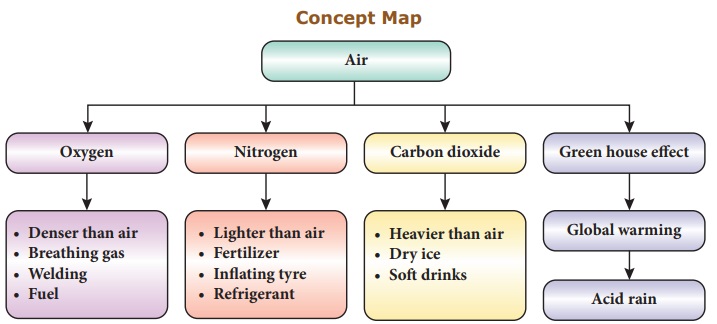Air | Chapter 11 | 8th Science - Points to Remember, Glossary, Concept Map | 8th Science : Chapter 11 : Air
Chapter: 8th Science : Chapter 11 : Air
Points to Remember, Glossary, Concept Map
Points to Remember
• Oxygen exists in nature as
silicates, carbonates, oxides and water. It also exists in free state as part
of air in the atmosphere.
• Oxygen is a colourless and
odourless gas. It dissolves sparingly in water. It is denser than air.
• Metals like magnesium, iron and
sodium burn in oxygen and give basic oxides.
• Bacteria convert atmospheric
nitrogen directly into soluble nitrogen compounds.
• Though nitrogen is inactive at
ordinary condition, it combines with many elements at high temperature and
pressure or in the presence of catalyst.
• Carbon dioxide cannot exist as a
liquid at atmospheric pressure. It occurs as carbonates in nature.
• Carbon dioxide is acidic in nature
and turns lime water milky. It is used in fire extinguisher.
• Global warming refers to an
average increase in the temperature of the atmosphere or simply it is the
warming of the earth.
• The green house gases are carbon
dioxide, methane, nitrous oxide, chlorofluoro carbons, etc.
GLOSSARY
1.
Atmosphere Gaseous
jacket that surrounds the earth.
2.
Fixation of nitrogen Process
that converts nitrogen in the air into a nitrogen compounds.
3.
Global warming An
average increase in the temperature of the atmosphere.
4.
Green house effect Trapping
of radiation from the sun by green house gases in the atmospherethat leads to
rise in the earth’s atmospheric temperature.
5.
Haber’s process Synthesis
of ammonia from nitrogen and hydrogen with the help of catalyst under 500 atm
pressure and 550˚C temperature.
6.
Oxygenes A Greek word
meaning ‘acid producers’ from which the name ‘Oxygen’ is derived.
7.
Soda water A form of water
produced when carbon dioxide is dissolved in water under pressure.
8.
Sublimation Process
of conversion of solid directly to vapour without reaching liquid state.
Concept Map

REFERENCE BOOKS
1. Environmental Science - Timothy O
Riordan Second edition
2. Basic of atmospheric science - A.
chandrasekar
3. Text book of Air pollution and
its control - S.C. Bhatia
INTERNET RESOURCES
1. www.chemicool.com
2. www.nationgeographic. com
3. www.environmentalpollutioncenters.org
ICT CORNER
AIR
Through
this activity you will know about carbon emission, climate change, global
average temperature etc.
Step 1
* Open the Browser and type the URL
given below.
* Click onany one of the items to
know about carbon emission, climate change, global average temperature, sea
level etc.
* For example, click on the “Climate
Time Machine” a popup screen will open. In that you can able to see carbon
emission global average sea level, temperature, sea ice etc.
* When you click global average sea
level, you will find year wise sea level.
Browse in the link:
https://climatekids.nasa. gov/menu/play/
Related Topics